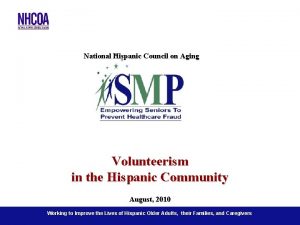Perceptions of Service Recovery Among Hispanic Americans THE

- Slides: 1

Perceptions of Service Recovery Among Hispanic Americans THE ROLE OF LANGUAGE AND ETHNIC IDENTIFICATION Student Researchers: Lisa Krautkramer & Katie Hammel | Faculty Mentor: Dr. Carol Azab Department of Management and Marketing | University of Wisconsin-Eau Claire INTRODUCTION Hispanics are the largest minority group in the United States and have a purchasing power that is equivalent to 1. 5 trillion dollars. Shopping behavior and the perceptions of advertising change with different ethnic groups. Yet despite the magnitude of the Hispanic minority group in the United States and these research findings, the role that ethnicity plays in the service failure and recovery literature is limited. This research seeks to add to this limited knowledge by exploring the role that language and ethnic identification play in service recovery among Hispanic Americans. Student actors played the role of the restaurant manager in the video scenario. The view of the camera was as if the person taking the survey was the customer. We also anticipate that respondents who viewed the scenario in English performed by a Caucasian manager will experience lower satisfaction with the service recovery and a lower repurchase intention (Scenario I). DISCUSSION WHAT IS A SERVICE FAILURE AND A SERVICE RECOVERY? Service failure is defined as a service performance that falls below a customer’s expectations. A service failure may occur for a variety of reasons, such as if a service is unavailable, if an employee fails to respond to customer needs, or when the service provider cannot deliver what was promised to the customer. A service recovery is the actions and activities a service provider and employees perform to rectify, amend, and restore the loss experienced by customers from deficiencies in service performance. In a service setting, service recovery involves a dynamic, contextual interaction between the service provider and the customer. Scenario I: Caucasian manager corrects the service failure in English Scenario II: Hispanic manager corrects the service failure in English MATERIALS AND The ETHODS study used a 2 x 2 between subjects experimental design in M which the ethnicity of the manager (Hispanic versus Caucasian) and the language that the manager spoke (Spanish versus English) were manipulated to create four different scenarios. A service failure was created in which a customer was billed a higher price than what the menu had stated. The waiter then called the manager over to begin the service recovery. Scenario III: Hispanic manager corrects the service failure in Spanish Scenario IV: Caucasian manager corrects the service failure in Spanish An online Qualtrics survey was created. Qualtrics was set to randomly play one of the four video scenarios for participants to see at the beginning of the survey. Questions were then asked after the scenario was played. These questions pertained to how satisfied they were with the service recovery. A snowballing sampling technique was used in which Hispanic respondents gave the survey link to others that they know. Respondents were incentivized by a prize. ANTICIPATED RESULTS Final data and results are currently being analyzed. Based on our hypotheses, we anticipate that respondents who strongly identify as Hispanics will report greater satisfaction with the service recovery if the recovery is performed in Spanish with a manager of their ethnicity (Scenario III). Receipt depicting the service failure of the customer being overcharged The final results of this study have several implications. First, the research will add to the limited prior research on ethnic identification and service recovery and help to gain a better understanding of the influence of ethnic identification and service recovery evaluation. In addition, the results of the study will help service providers in segmenting and targeting customers by understanding the different attitudes and behaviors of Hispanic customers. The study also has managerial implications. The research will aid managers in providing better service recovery strategies to make the service experience positive and memorable and to help regain trust and build customer loyalty after a service failure. Study findings will also assist managers in recruiting the right frontline employees, such as deciding whether to hire more minority employees or employees who can speak Spanish fluently. WHAT IS ETHNIC IDENTIFICATION? Ethnic identification is how well an individual relates with his or her ethnic group. Customers might use race, religion, customs, language, and their country of origin as ways of identifying with their culture. Although the intensity of ethnic identification has been found to affect consumer behavior, there has been limited research on how the strength of ethnic identification relates to service failure and recovery among Hispanic Americans. Thus, further research is needed to examine whether customers may evaluate the recovery after a service failure more or less favorable when interacting with a service provider of their own ethnicity. In addition, they will report positive word of mouth, trust, and a higher repurchase intention with a Hispanic manager who communicates in Spanish. REFERENCES A Fresh View of Hispanic Consumers. (2014). Retrieved from http: //www. nielsen. com/us/en/insights/news/2014/a-fresh-view-ofhispanic-consumers. html Baker, T. , Meyer, T. & Johnson, J. (2008). Individual differences in perceptions of service failure and recovery: the role of race and discriminatory bias. Journal of the Academy of Marketing Science 36: 552 – 564. Chung-Herrera, B. G. , Gonzalez, G. R. , & Hoffman, K. D. (2010). Demographic differences exist: an analysis of service failure recovery among diverse participants. Journal of Services Marketing 24 (2): 128 -141. Deshpandé, R. & Stayman, D. M. (1994). A Tale of Two Cities: Distinctiveness Theory and Advertising Effectiveness. Journal of Marketing Research 31: 57 -64. Holmqvist, J. (2011). Consumer language preferences in service encounters: a cross-cultural perspective. Managing Service Quality 21 (2): 178 -191. Van Vaerenbergh, Y. & Holmqvist, J. (2013). Speak my language if you want my money. Service language’s influence on consumer tipping behavior. European Journal of Marketing 47(8): 1276 -1292. We thank the Office of Research and Sponsored Programs for supporting this research, and Learning & Technology Services for printing this poster.

